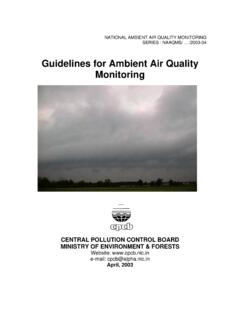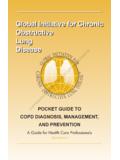Transcription of ENVIRONMENTAL NOISE
1 ENVIRONMENTALNOISE GUIDELINESfor the European RegionEXECUTIVE SUMMARY2 Abstract NOISE is an important public health issue. It has negative impacts on human health and well-being and is a growing concern. The WHO Regional Office for Europe has developed these guidelines , based on the growing understanding of these health impacts of exposure to ENVIRONMENTAL NOISE . The main purpose of these guidelines is to provide recommendations for protecting human health from exposure to ENVIRONMENTAL NOISE originating from various sources: transportation (road traffic, railway and aircraft) NOISE , wind turbine NOISE and leisure NOISE . They provide robust public health advice underpinned by evidence, which is essential to drive policy action that will protect communities from the adverse effects of NOISE . The guidelines are published by the WHO Regional Office for Europe. In terms of their health implications, the recommended exposure levels can be considered applicable in other regions and suitable for a global audience.
2 The full publication of the guidelines can be downloaded here: ADVERSE EFFECTS, PREVENTION AND CONTROLENVIRONMENTAL EXPOSURE ADVERSE EFFECTS, PREVENTION AND CONTROLGUIDELINES EUROPE World Health Organization 2018 All rights reserved. The Regional Office for Europe of the World Health Organization welcomes requests for permission to reproduce or translate its publications, in part or in designations employed and the presentation of the material in this publication do not imply the expression of any opinion whatsoever on the part of the World Health Organization concerning the legal status of any country, territory, city or area or of its authorities, or concerning the delimitation of its frontiers or boundaries. Dotted lines on maps represent approximate border lines for which there may not yet be full mention of specific companies or of certain manufacturers products does not imply that they are endorsed or recommended by the World Health Organization in preference to others of a similar nature that are not mentioned.
3 Errors and omissions excepted, the names of proprietary products are distinguished by initial capital reasonable precautions have been taken by the World Health Organization to verify the information contained in this publication. However, the published material is being distributed without warranty of any kind, either expressed or implied. The responsibility for the interpretation and use of the material lies with the reader. In no event shall the World Health Organization be liable for damages arising from its use. The views expressed by authors, editors, or expert groups do not necessarily represent the decisions or the stated policy of the World Health requests about publications of the WHO Regional Office for Europe to: Publications WHO Regional Office for Europe UN City, Marmorvej 51 DK-2100 Copenhagen , DenmarkAlternatively, complete an online request form for documentation, health information, or for permission to quote or translate, on the Regional Office website ( ).
4 3 Executive summaryEnvironmental NOISE is an important public health issue, featuring among the top ENVIRONMENTAL risks to health. It has negative impacts on human health and well-being and is a growing concern among both the general public and policy-makers in Europe. At the Fifth Ministerial Conference on Environment and Health in Parma, Italy, in 2010, WHO was requested by the Member States in the European Region to produce NOISE guidelines that included not only transportation NOISE sources but also personal electronic devices, toys and wind turbines, which had not yet been considered in existing guidelines . Furthermore, European Union Directive 2002/49/EC relating to the assessment and management of ENVIRONMENTAL NOISE (END) and related technical guidance from the European Environment Agency both elaborated on the issue of ENVIRONMENTAL NOISE and the importance of up-to-date NOISE guidelines .
5 The WHO Regional Office for Europe has therefore developed ENVIRONMENTAL NOISE guidelines for the European Region, proposing an updated set of public health recommendations on exposure to ENVIRONMENTAL main purpose of these guidelines is to provide recommendations for protecting human health from exposure to ENVIRONMENTAL NOISE originating from various sources: transportation (road traffic, railway and aircraft) NOISE , wind turbine NOISE and leisure NOISE . Leisure NOISE in this context refers to all NOISE sources that people are exposed to due to leisure activities, such as attending nightclubs, pubs, fitness classes, live sporting events, concerts or live music venues and listening to loud music through personal listening devices. The guidelines focus on the WHO European Region and provide policy guidance to Member States that is compatible with the NOISE indicators used in the European Union s END.
6 The following two key questions identify the issues addressed by the guidelines . In the general population exposed to ENVIRONMENTAL NOISE , what is the exposure response relationship between exposure to ENVIRONMENTAL NOISE (reported as various indicators) and the proportion of people with a validated measure of health outcome, when adjusted for confounders? In the general population exposed to ENVIRONMENTAL NOISE , are interventions effective in reducing exposure to and/or health outcomes from ENVIRONMENTAL NOISE ? In light of these questions, the guidelines set out to define recommended exposure levels for ENVIRONMENTAL NOISE in order to protect population health. Methods used to develop the guidelines The process of developing the WHO guidelines followed a rigorous methodology involving several groups with separate roles and responsibilities. Throughout the process, the Grading of Recommendations Assessment, Development and Evaluation (GRADE) approach was followed.
7 In particular, the different steps in the development of the guidelines included: formulation of the scope and key questions of the guidelines ; review of the pertinent literature; selection of priority health outcome measures; a systematic review of the evidence; 4 assessment of certainty of the bodies of evidence resulting from systematic reviews; identification of guideline exposure levels; and setting of the strength of recommendations. Based on the defined scope and key questions, these guidelines reviewed the pertinent literature in order to incorporate significant research undertaken in the area of ENVIRONMENTAL NOISE and health since the community NOISE guidelines and night NOISE guidelines for Europe were issued (WHO, 1999; WHO Regional Office for Europe, 2009). In total, eight systematic reviews of evidence were conducted to assess the relationship between ENVIRONMENTAL NOISE and the following health outcomes: cardiovascular and metabolic effects; annoyance; effects on sleep; cognitive impairment; hearing impairment and tinnitus; adverse birth outcomes; and quality of life, mental health and well-being.
8 A separate systematic review of evidence was conducted to assess the effectiveness of ENVIRONMENTAL NOISE interventions in reducing exposure and associated impacts on Once identified and synthesized, the quality of the evidence of the systematic reviews was assessed by the Systematic Review Team. Subsequently, the Guideline Development Group (GDG) formulated recommendations, guided by the Systematic Review Team s assessment and informed by of a number of additional contextual parameters. To facilitate the formulation of recommendations, the GDG first defined priority health outcomes and then selected the most relevant health outcome measures for the outcomes. Consecutively, a process was developed to identify the guideline exposure levels with the help of the exposure response functions provided by the systematic reviews. To reflect the nature of the research (observational studies) underpinning the relationship between ENVIRONMENTAL NOISE and health, the GRADE procedures were adapted to the requirements of ENVIRONMENTAL exposure studies where needed.
9 NOISE indicatorsFrom a scientific point of view, the best NOISE indicator is the one that performs best in predicting the effect of interest. There are, however, a number of additional criteria that may influence the choice of indicator. For example, various indicators might be suitable for different health end-points. Some considerations of a more political nature can be found in the European Commision s Position paper on EU NOISE indicators (EC, 2000). The current guidelines are intended to be suitable for policy-making in the WHO European Region. They therefore focus on the most used NOISE indicators Lden and/or Lnight. They can be constructed using their components (Lday, Levening, Lnight and the duration in hours of Lnight), and are provided for exposure at the most exposed fa ade, outdoors. The Lden and Lnight indicators are those generally reported by authorities and are widely used for exposure assessment in health effect studies.
10 1 All systematic reviews are publicly available online in the International Journal of ENVIRONMENTAL Research and Public Health. A detailed list of links to the individual reviews is provided in section of these recommendations have been formulated for road traffic NOISE , railway NOISE , aircraft NOISE , wind turbine NOISE and leisure NOISE . Recommendations are rated as either strong or conditional. Strength of recommendation A strong recommendation can be adopted as policy in most situations. The guideline is based on the confidence that the desirable effects of adherence to the recommendation outweigh the undesirable consequences. The quality of evidence for a net benefit combined with information about the values, preferences and resources inform this recommendation, which should be implemented in most circumstances. A conditional recommendation requires a policy-making process with substantial debate and involvement of various stakeholders.
















